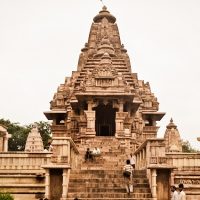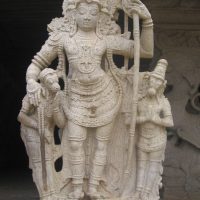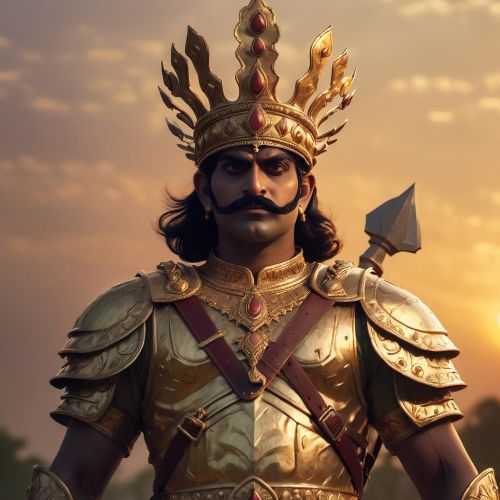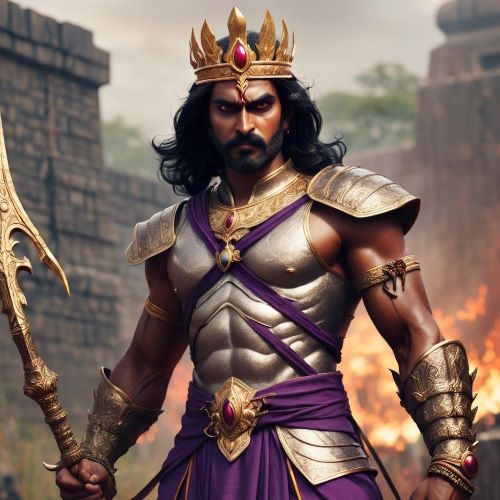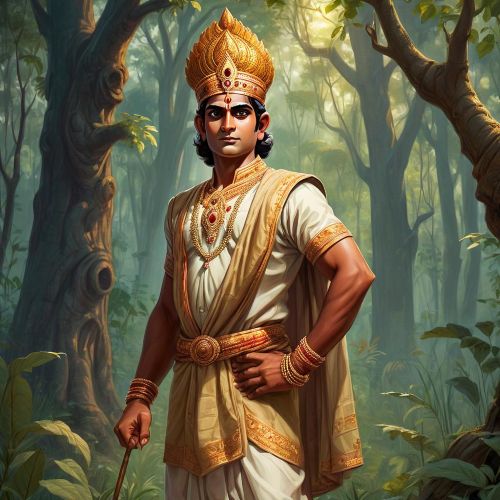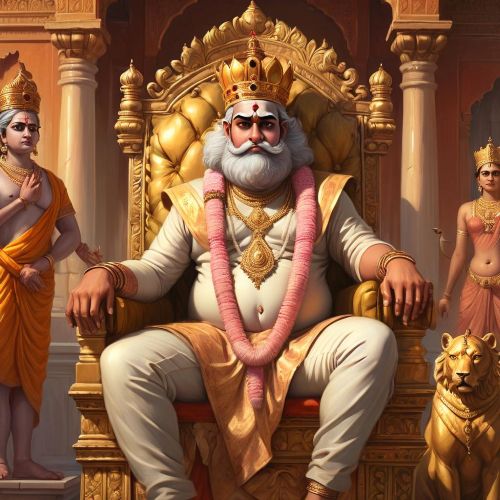Lakshmana : The Devoted Brother
Listen
At a glance
| Description | |
|---|---|
| Origin | Indian Mythology |
| Classification | Mortals |
| Family Members | Dasharatha (Father), Sumitra (Mother), Rama, Shatrughna, Bharatha (Brothers), Urmila (Wife) |
| Region | India |
| Associated With | Devotion, Royalty |
Lakshmana
Introduction
Lakshmana, one of the most admired figures in Hindu mythology, stands as the embodiment of loyalty, courage, and brotherly devotion in the Ramayana. Born to King Dasharatha and Queen Sumitra, Lakshmana is revered as the younger brother and steadfast companion of Lord Rama, the seventh incarnation of Vishnu. His role in the epic is not merely supportive—Lakshmana represents unwavering righteousness (dharma) and sacrifice, standing as the ideal of service and dedication. Considered an incarnation of Shesha, the divine serpent upon whom Vishnu rests, Lakshmana’s presence symbolizes cosmic balance and divine duty. His journey alongside Rama and Sita through exile, hardship, and war has immortalized him as the epitome of selfless love and devotion in Hindu tradition.
Physical Traits
Lakshmana is described in ancient scriptures as strikingly handsome, powerful, and radiant with youthful vigor. His complexion is often said to be golden or fair, his frame strong and athletic—fitting for a warrior prince of Ayodhya. He is frequently depicted holding a bow and quiver, dressed in royal garments that signify both his nobility and readiness for battle. Unlike Rama’s serene and calm demeanor, Lakshmana’s face is often marked with intensity, reflecting his passionate and protective nature. His eyes convey alertness and purpose, symbolizing his ceaseless vigilance during Rama’s exile. According to Valmiki’s Ramayana, Lakshmana’s physical strength was matched only by his inner discipline and moral fortitude, making him not just a warrior but a guardian of virtue.
Family
Lakshmana was born as one of the four sons of King Dasharatha of Ayodhya, belonging to the illustrious Ikshvaku dynasty of the Solar race (Suryavansha). His mother, Queen Sumitra, bore twins—Lakshmana and Shatrughna—through the divine sacrificial offering distributed among Dasharatha’s queens. From childhood, Lakshmana shared an inseparable bond with Rama, his half-brother born to Queen Kausalya. When Rama was exiled to the forest for fourteen years, Lakshmana chose to accompany him, leaving behind royal life and his wife, Urmila, daughter of King Janaka and sister of Sita. Urmila’s quiet sacrifice—remaining behind without complaint—parallels Lakshmana’s devotion to Rama. The couple had two sons, Angada and Chandraketu, whose lineage continued the valor of Ayodhya’s royal bloodline. Lakshmana’s familial ties are central to his identity, intertwining duty, love, and sacrifice in equal measure.
Other names
Across the many retellings of the Ramayana, Lakshmana is known by numerous epithets that reflect his character and heritage. Saumitra, meaning “son of Sumitra,” honors his mother. Ramanuja, translating to “younger brother of Rama,” encapsulates his lifelong devotion to his elder brother. In northern India, he is affectionately called Lakhan, while in Tamil traditions he is revered as Ilaiya Perumal, or “the younger lord.” Another well-known title, Gudakesha, or “the one who conquered sleep,” refers to his extraordinary vow to remain awake throughout Rama and Sita’s exile, standing guard every night. These epithets, drawn from regional and linguistic traditions, reveal the widespread reverence for Lakshmana’s noble virtues and his universal appeal across centuries of devotion.
Powers and Abilities
As an incarnation of Shesha, Lakshmana possessed divine energy and unyielding strength. His skill in warfare was unparalleled, and his training under sages like Vishvamitra and Vashishtha made him a master of celestial weapons (Divyastras). Alongside Rama, he received the sacred knowledge of Bala and Atibala mantras, granting him supernatural endurance and invincibility. Lakshmana’s valor was proven in battles against demons such as Maricha and Subahu, and most notably in his defeat of Indrajit (Meghanada), Ravana’s formidable son, during the war in Lanka. His ability to remain conscious and vigilant for fourteen years, fueled by devotion rather than rest, illustrates his extraordinary willpower. Even when grievously wounded by Indrajit’s powerful weapon, Lakshmana’s strength was revived by Rama’s presence and the chanting of his name, symbolizing the inseparable spiritual bond between the brothers. His powers extended beyond physical prowess—his self-control, righteousness, and sharp intellect made him an ideal protector, strategist, and devotee.
Modern Day Influence
Lakshmana’s influence extends far beyond the pages of ancient scripture, continuing to shape Indian thought, ethics, and cultural identity. His story represents the timeless ideal of selfless service and steadfast loyalty. The phrase Lakshman Rekha, referring to the protective boundary he drew around Sita’s dwelling during exile, has entered the Indian lexicon as a metaphor for moral and ethical limits that must not be crossed. His character is celebrated in festivals like Rama Navami and Dussehra, where performances of Ramlila dramatize his heroism and devotion. Temples dedicated to the Ram Parivar (Rama, Sita, Lakshmana, and Hanuman) can be found across India, particularly in Uttar Pradesh and Kerala, where he is venerated as a symbol of virtue and protection.
In literature, Lakshmana’s story has inspired countless poets and writers—from Valmiki’s Ramayana and Tulsidas’s Ramcharitmanas to modern retellings in English, Tamil, and Hindi. His character has been reinterpreted in plays, novels, and contemporary fiction, reflecting his moral complexity and emotional depth. Modern novels like Lakshmana by T.N. Prabhakar and LakshmiLa: The Eternal Love Story by Shubhi Agarwal reimagine his struggles, loyalty, and unspoken sacrifices.
In popular media, Lakshmana continues to capture audiences through television and film. Sunil Lahri’s portrayal in Ramanand Sagar’s Ramayan (1987) became iconic, while recent adaptations such as Adipurush (2023) and Shrimad Ramayan (2024) introduce his legend to younger generations. His representation in art, theatre, and digital media underscores the enduring relevance of his virtues in the modern world.
Beyond religion and entertainment, Lakshmana’s life serves as an ethical framework in leadership, education, and philosophy. His unwavering sense of duty is cited in discussions on moral conduct, loyalty, and discipline. He symbolizes ideal brotherhood and mentorship—qualities that resonate in contemporary discourse on teamwork and integrity. In some Southeast Asian countries influenced by the Ramayana, such as Indonesia and Malaysia, military ranks equivalent to admirals are still titled Lakshmana, a testament to his enduring association with valor and leadership.
Related Images
Source
Apam Napa. (2025). Laxmana – Devoted Brother of Rama. Retrieved from https://apam-napat.com/entities-laxmana/
Britannica. (2025). Lakshmana | Hindu mythology. Retrieved from https://www.britannica.com/biography/Lakshmana
Wisdomlib. (2025). Lakshmana: Significance and symbolism. Retrieved from https://www.wisdomlib.org/concept/lakshmana
Ramana Maharshi Foundation. (2024). Lakshman: The Loyal Brother of Rama in the Ramayana. Retrieved from https://www.ramana-maharshi.org/lakshman-the-loyal-brother-of-rama-in-the-ramayana/
WowNandi. (2025). Lakshman in Ramayana: A Step-by-Step Character Study. Retrieved from https://www.wownandi.com/blogs/timelesstraditions/lakshman-in-ramayana-a-step-by-step-character-study
KrishnasMercy. (2021). Three Extraordinary Abilities in Lakshmana. Retrieved from https://krishnasmercy.com/2021/01/25/three-extraordinary-abilities-in-lakshmana/
Scribd. (2025). Roles of Lakshmana. Retrieved from https://www.scribd.com/document/494388407/Roles-of-Lakshmana
Meghna Unni. (2020). Lakshmana from Ramayana | A Character Sketch. Retrieved from https://www.meghnaunni.com/2020/04/lakshmana-from-ramayana-a-character-sketch/
World Mythos. (2024). Lakshmana. https://worldmythos.com/lakshmana/
Goldman, R. P. (2007). The Ramayana of Valmiki: An Epic of Ancient India. Princeton University Press.
Bhattacharji, S. (1990). Legends of Devi. Orient Longman.
Doniger, W. (2009). The Hindus: An Alternative History. Penguin Books.
Narayan, R. K. (1972). The Ramayana: A Shortened Modern Prose Version of the Indian Epic. Viking Press.
Pattanaik, D. (2010). Jaya: An Illustrated Retelling of the Mahabharata. Penguin India.
Frequently Asked Questions
What is lorem Ipsum?
I am text block. Click edit button to change this text. Lorem ipsum dolor sit amet, consectetur adipiscing elit. Ut elit tellus, luctus nec ullamcorper mattis, pulvinar dapibus leo.
What is lorem Ipsum?
I am text block. Click edit button to change this text. Lorem ipsum dolor sit amet, consectetur adipiscing elit. Ut elit tellus, luctus nec ullamcorper mattis, pulvinar dapibus leo.
What is lorem Ipsum?
I am text block. Click edit button to change this text. Lorem ipsum dolor sit amet, consectetur adipiscing elit. Ut elit tellus, luctus nec ullamcorper mattis, pulvinar dapibus leo.
What is lorem Ipsum?
I am text block. Click edit button to change this text. Lorem ipsum dolor sit amet, consectetur adipiscing elit. Ut elit tellus, luctus nec ullamcorper mattis, pulvinar dapibus leo.
What is lorem Ipsum?
I am text block. Click edit button to change this text. Lorem ipsum dolor sit amet, consectetur adipiscing elit. Ut elit tellus, luctus nec ullamcorper mattis, pulvinar dapibus leo.





